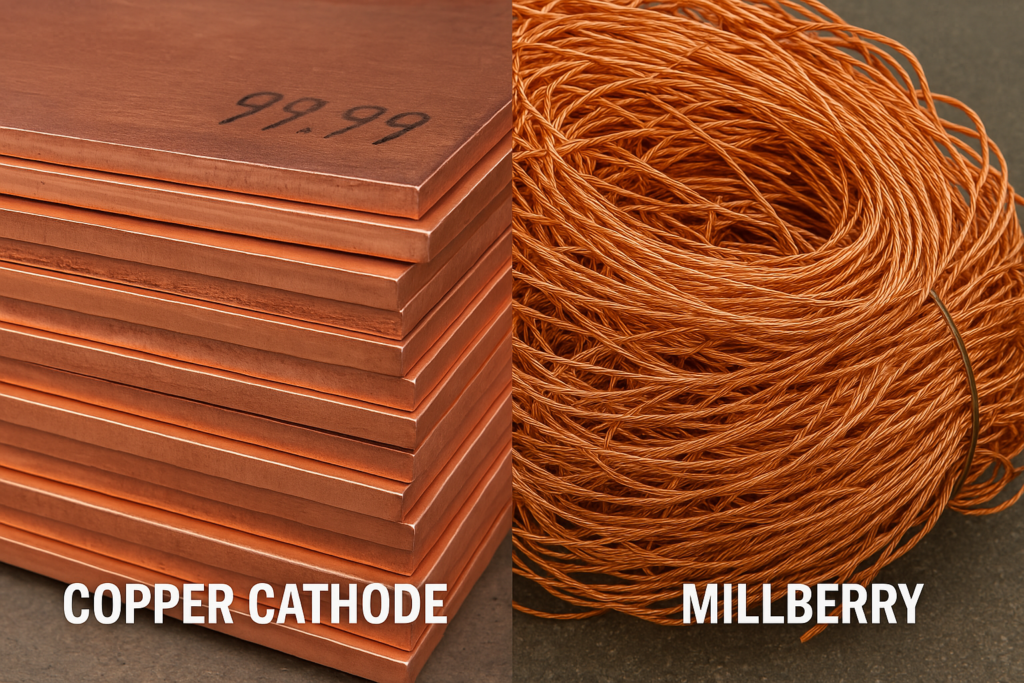
Copper remains a critical industrial metal, indispensable in sectors ranging from electrical engineering to manufacturing and infrastructure. For stakeholders operating in metal procurement, recycling, and trading, understanding copper classifications is essential. Among the most widely referenced copper products in international trade are Copper Cathode and Millberry. Though both are high-purity forms of copper, they differ significantly in origin, form, and application.
Copper cathodes are flat plates of refined copper with a purity of 99.99% or higher, typically produced through an electrolytic refining process. In this process, impure copper anodes are dissolved and redeposited onto pure starter sheets (cathodes), yielding highly refined copper.
Typical uses include:
Electrical conductors (wiring, busbars, cables)
Copper rods and tubes
Printed circuit boards
Plumbing and refrigeration components
Production of copper alloys such as brass and bronze
Copper cathode is often traded internationally under the LME Grade A specification, which mandates conformance with BS EN 1978:1998 standards.
Millberry copper refers to the highest grade of bare, uncoated, and unalloyed copper wire scrap, sourced primarily from used electrical cables. To qualify as Millberry, the copper must be:
Clean and bright
Free from insulation, solder, oil, or corrosion
Approximately 99.95% copper or higher in content
It is the preferred grade of copper scrap for remelting because of its cleanliness and high yield during smelting.
Common applications include:
Feedstock for copper smelters
Raw material for refining into cathode
Production of new electrical wire and rods
Though both materials are suitable for high-conductivity applications, they vary in origin, handling, and market value:
| Feature | Copper Cathode | Millberry Copper Scrap |
|---|---|---|
| Source | Primary electrolytic refining | Recycled electrical cables |
| Purity | 99.99%+ | ~99.95% |
| Form | Flat metal sheets | Bright stripped wire |
| Processing | Ready for direct use | Requires remelting |
| Common Use | Direct fabrication | Re-refining or rod casting |
| Cost | Higher | Lower |
In international transactions, it is vital to verify the chemical composition and packaging requirements of copper products. Documents such as:
Certificate of Analysis (CoA)
Packing list
Material Safety Data Sheet (MSDS)
are essential for customs clearance, compliance, and quality assurance. For Millberry, adherence to ISRI specifications, particularly the “Berry” category, is a key benchmark.
Copper prices are typically benchmarked against London Metal Exchange (LME) quotations. Copper cathode commands a premium due to its purity and readiness for use in manufacturing. Millberry prices, while slightly discounted, remain high due to strong demand from recyclers and smelters seeking clean, high-yield scrap.
Both Copper Cathode and Millberry copper serve critical roles in the global copper supply chain. While cathode offers unmatched purity suitable for direct manufacturing, Millberry presents a sustainable and cost-effective source of refined copper when processed appropriately. Understanding these distinctions is vital for informed procurement, compliance with quality standards, and optimised resource utilisation in the metals industry.
We use cookies to give you the best online experience. By agreeing you accept the use of cookies in accordance with our cookie policy.